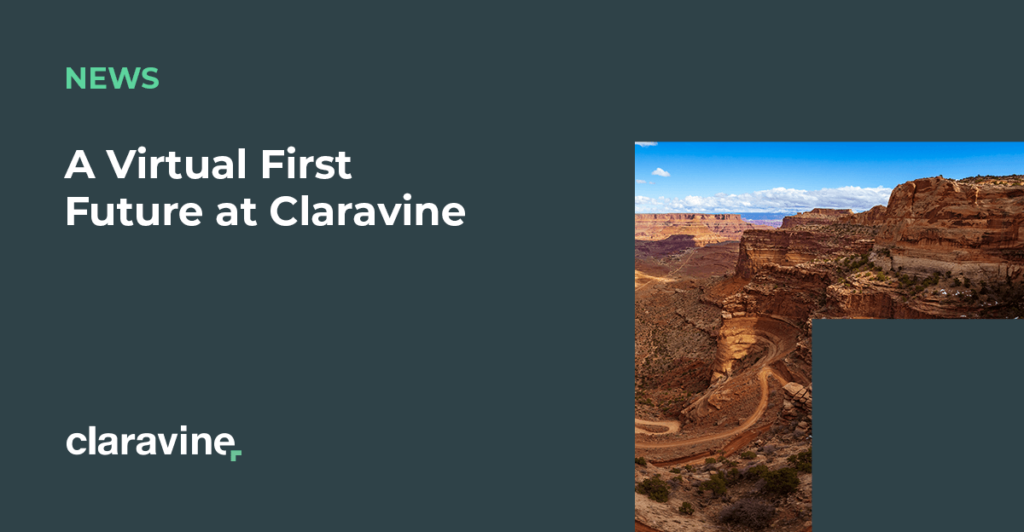A Virtual-First Future at Claravine

At Claravine, the year 2020 taught us that we can not only survive having our world turned upside down, we can actually thrive. We have seen the future of workplace collaboration and it is all about flexibility. This means something different for everyone. Some folks prefer to work in a traditional office setting with the ability to collaborate in person. Others have been inspired to create a productive home office where they connect digitally. We’ve learned that we can hire talented people and not be limited by geography. We are taking the best of all of these worlds and creating a company where we have permission to tap into our personal preferences, come together, work hard, and create something pretty awesome.
While we are still trying to land on our feet in a (hopefully) post-pandemic world, we have realized that the path to success is less about “busyness” and more about impact. We have a bias towards simplicity and know that less is more. The changes we are talking about require patience and flexibility.
Our intent is to design “workplaces” that are world class in efficiency and productivity. To do this, these three building blocks are the foundation upon which our growing company is going to be built: creating a strong sense of belonging and engagement, implementing a system for productive teamwork, and consciously focusing on wellness and balance within our culture.
Belonging and Engagement
Our team’s greatest asset is our people. We are committed to their development and their feeling of belonging and engagement at work. We use both team building activities and meaningful mentorship experiences to create belonging within the company and to support the personal and professional growth of each employee.
Because our team is spread out across North America, it is important to bring everyone together in person at least once per year. The intent of this annual summit is to build a sense of unity, reinforce our mission and vision, engage our creative thinking and problem solving and just have fun together.
We have other company and team events planned over the course of the year. Activities that have traditionally been held in person and discussed over the water cooler can be retooled to include people no matter where they are. These events can be planned together, executed locally or remotely, and include such things as cycling, running, and endurance races; competitions like March Madness, NBA championships, and the World Cup; digital game nights; online cooking and art classes; viewing parties; office “lunches” via DoorDash for special occasions and milestones, and cross-team community service opportunities.
Events are not the only avenue we are pursuing to reinforce a sense of belonging.
While it may not yet be fancy in its design, we are rolling out a company intranet that highlights announcements and updates, HR basics and onboarding information, and includes company reports and dashboards so that information is centralized and easily accessible.
Additionally, we see the power in supporting every individual team member’s growth as an essential part of their contribution to the company. Each employee participates in productive, meaningful, well-defined and consistent 1:1’s with their leader, as well as annual evaluation meetings to review strengths and growth opportunities. In addition, we facilitate product knowledge and training, teach diversity, equity and inclusion through programs that build diversity versus buy diversity, and encourage time off for career and personal development through existing online resources.
Ongoing feedback to our leadership team (eNPS surveys, an anonymous feedback channel) is also helpful to reinforce and empower employee ownership of company culture.
Productive Teamwork
We aim to structure a work week that maximizes productivity and minimizes burnout. The most effective teams have documented and agreed-upon norms that help propel productivity and the individuals who comprise those teams have well-defined work processes to manage time and tasks.
We decided to have “core” business hours during which company-wide and team-wide synchronous collaboration and meetings occur. This window maximizes the availability of team members across all time zones represented in our company and ensures that we recognize the fact that we don’t all start and end work at the same time. Additionally, department specific business hours are determined by each team, with a particular focus on being flexible to accommodate team members and to ensure support for customers and customer facing teams.
We empower our people to know when and how they work best and coordinate accordingly with their teams. We encourage them to assess their workload and schedule blocks for focused, deep work, and silence notifications. They can then utilize less productive hours for email, calendaring and less demanding tasks. We want them to audit their calendars, assess how they really spend their time and make adjustments as needed to maximize efficiency.
When it comes to meetings, our company mantra is: if in doubt, don’t have it. We use asynchronous tools where appropriate to facilitate collaboration. When we do have meetings, they are either fully remote or fully in-person as we believe that mixed meetings limit engagement. We try to match meeting length to objective, invite only those necessary to achieve the purpose of the meeting and end early if possible. We encourage people to be mindful of time zones and respect colleagues’ personal blocks on calendars. While we know urgent meetings outside of these windows come up, they need to be negotiated, not just added to calendars.
To make the most of meeting time, we follow some best practices. Agendas are sent out in advance with a defined purpose and most important outcomes. We encourage attendees to be present with their camera on whenever possible and to minimize possible distractions. The goal is to start and end meetings on time and stick to the agenda. Prior to the end of any meeting, we clearly define responsibilities and set deadlines for deliverables.
With people spread out in so many locations, communication is key. We have some codes of communication that help things move smoothly. We write to be understood, not just heard. We aim to be concise, including clear take-aways and calls to action. We assume best intentions and are careful to make sure we are mindful that not everything translates well in digital. We have defined the ways that we communicate most often (phone, meetings, Slack, email, google docs, Asana/Jira/Miro) and have identified the best use cases for each tool.
Wellness and Balance
We are not just interested in the work side of our team. We hired them as whole people and therefore take their health and wellness seriously. Finding a balance with all that they need AND want to do is a top priority.
The old work model of heading into the office every day is all but gone and we want our people to have a say in where they work. If they choose to work from home, they need a private, non-distracting space with a comfortable work chair, noise-cancelling headphones, and an adjustable height desk with any plants, family photos or other personal items that will inspire and motivate them. We established a budget for employees and they each receive an equipment stipend to cover setting up their ideal work situation. If working from home is not optimal, we offer the alternative of working in a local tech hub and small workspaces in places where we have a higher concentration of employees.
We have learned that rituals matter. We believe that establishing consistent patterns to the day, especially when working from home, is important. Things like taking a shower, brushing your teeth and getting dressed everyday seem rather obvious but can be surprisingly helpful. Scheduling breaks to walk, stretch, move your body or meditate, help to stay alert and productive. We feel it is important to bui
ld transitions at the start and end of each work day. For example, tidying up your desk, shutting down your computer and telling your brain that you are done can be a healthy way to close the day.
Some other wellness behaviors we encourage are practicing self-compassion with positive self-talk, seeking out social connections, and minding mental health with therapy, coaching or other forms of support. We know it is critical to calendar zen-time by blocking off time to exercise or pursue hobbies. We have come to appreciate that knowing what drains you and when to stop can help avoid burnout. Optimal performance happens when we are challenged but not exhausted or overly frustrated and so defining healthy boundaries, and enforcing them, is very important.
Recharging is important and so we encourage our team to take time off. We offer flexible PTO, hack days, summer hours, time off to volunteer in the community as well as to develop themselves in their career, learning our product or developing knowledge around diversity, equity and inclusion.
At this point, it may sound as though we have cracked the code and mastered the modern workspace. Far from it. We have tried to be intentional in our design of a hybrid work model and we know that we will always be tweaking and improving it. But despite the many downsides of the past year, at the very least, we know that this new way of approaching work CAN work and we are committed to giving it a go.



